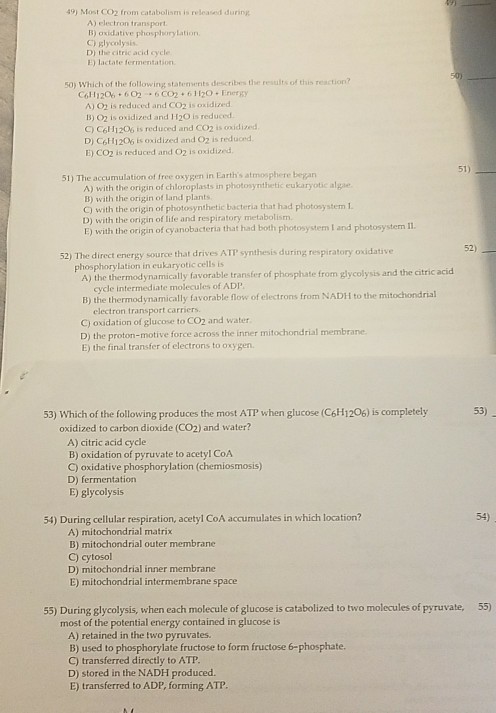Answered step by step
Verified Expert Solution
Question
1 Approved Answer
49) Most CO from catabolism is released during A) electron transport. B) oxidative phosphorylation. C) glycolysis. D) the citric acid cycle.. E) lactate fermentation.

49) Most CO from catabolism is released during A) electron transport. B) oxidative phosphorylation. C) glycolysis. D) the citric acid cycle.. E) lactate fermentation. 50) Which of the following statements describes the results of this reaction? C6H12066026CO2 +61120+ Energy A) O is reduced and CO2 is oxidized B) O2 is oxidized and H2O is reduced. C) C6H1206 is reduced and CO2 is oxidized. D) C6H1206 is oxidized and O2 is reduced. E) CO is reduced and O2 is oxidized. 51) The accumulation of free oxygen in Earth's atmosphere began i A) with the origin of chloroplasts in photosynthetic eukaryotic algae. B) with the origin of land plants. C) with the origin of photosynthetic bacteria that had photosystem 1. D) with the origin of life and respiratory metabolism. E) a the origin of cyanobacteria that had both photosystem I and photosystem II. 52) The direct energy source that drives ATP synthesis during respiratory oxidative phosphorylation in eukaryotic cells is A) the thermodynamically favorable transfer of phosphate from glycolysis and the citric acid cycle intermediate molecules of ADP. B) the thermodynamically favorable flow of electrons from NADH to the mitochondrial electron transport carriers. C) oxidation of glucose to CO2 and water. D) the proton-motive force across the inner mitochondrial membrane. E) the final transfer of electrons to oxygen. 53) Which of the following produces the most ATP when glucose (C6H1206) is completely oxidized to carbon dioxide (CO2) and water? A) citric acid cycle B) oxidation of pyruvate to acetyl CoA C) oxidative phosphorylation (chemiosmosis) D) fermentation E) glycolysis 54) During cellular respiration, acetyl CoA accumulates in which location? A) mitochondrial matrix B) mitochondrial outer membrane C) cytosol D) mitochondrial inner membrane E) mitochondrial intermembrane space 50) B) used to phosphorylate fructose to form fructose 6-phosphate. C) transferred directly to ATP. D) stored in the NADH produced. E) transferred to ADP, forming ATP. M 51) 55) During glycolysis, when each molecule of glucose is catabolized to two molecules of pyruvate, most of the potential energy contained in glucose is A) retained in the two pyruvates. 52) 53) 54) 55)
Step by Step Solution
★★★★★
3.47 Rating (154 Votes )
There are 3 Steps involved in it
Step: 1
Ans 49 D During citric acid cycle EXPLANATION During the complete catabolism of glucose CO2 is released during C Krebs cycle and oxidation of pyruvate The Krebs cycle produces CO2 molecules at three d...
Get Instant Access to Expert-Tailored Solutions
See step-by-step solutions with expert insights and AI powered tools for academic success
Step: 2

Step: 3

Ace Your Homework with AI
Get the answers you need in no time with our AI-driven, step-by-step assistance
Get Started


